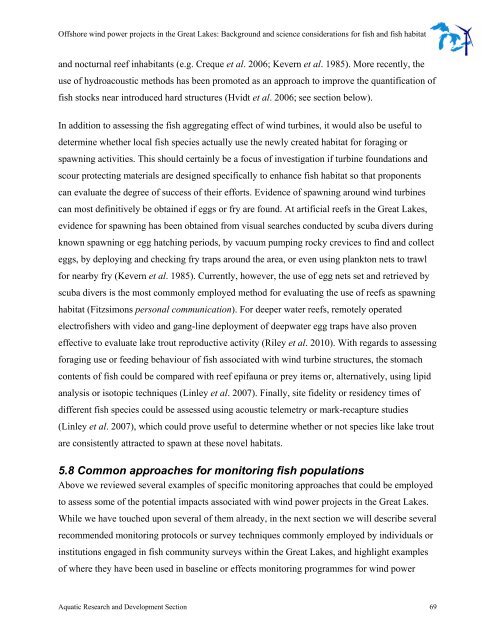Offshore Wind Power Projects in the Great Lakes - Ministry of ...
Offshore Wind Power Projects in the Great Lakes - Ministry of ...
Offshore Wind Power Projects in the Great Lakes - Ministry of ...
Create successful ePaper yourself
Turn your PDF publications into a flip-book with our unique Google optimized e-Paper software.
<strong>Offshore</strong> w<strong>in</strong>d power projects <strong>in</strong> <strong>the</strong> <strong>Great</strong> <strong>Lakes</strong>: Background and science considerations for fish and fish habitat<br />
and nocturnal reef <strong>in</strong>habitants (e.g. Creque et al. 2006; Kevern et al. 1985). More recently, <strong>the</strong><br />
use <strong>of</strong> hydroacoustic methods has been promoted as an approach to improve <strong>the</strong> quantification <strong>of</strong><br />
fish stocks near <strong>in</strong>troduced hard structures (Hvidt et al. 2006; see section below).<br />
In addition to assess<strong>in</strong>g <strong>the</strong> fish aggregat<strong>in</strong>g effect <strong>of</strong> w<strong>in</strong>d turb<strong>in</strong>es, it would also be useful to<br />
determ<strong>in</strong>e whe<strong>the</strong>r local fish species actually use <strong>the</strong> newly created habitat for forag<strong>in</strong>g or<br />
spawn<strong>in</strong>g activities. This should certa<strong>in</strong>ly be a focus <strong>of</strong> <strong>in</strong>vestigation if turb<strong>in</strong>e foundations and<br />
scour protect<strong>in</strong>g materials are designed specifically to enhance fish habitat so that proponents<br />
can evaluate <strong>the</strong> degree <strong>of</strong> success <strong>of</strong> <strong>the</strong>ir efforts. Evidence <strong>of</strong> spawn<strong>in</strong>g around w<strong>in</strong>d turb<strong>in</strong>es<br />
can most def<strong>in</strong>itively be obta<strong>in</strong>ed if eggs or fry are found. At artificial reefs <strong>in</strong> <strong>the</strong> <strong>Great</strong> <strong>Lakes</strong>,<br />
evidence for spawn<strong>in</strong>g has been obta<strong>in</strong>ed from visual searches conducted by scuba divers dur<strong>in</strong>g<br />
known spawn<strong>in</strong>g or egg hatch<strong>in</strong>g periods, by vacuum pump<strong>in</strong>g rocky crevices to f<strong>in</strong>d and collect<br />
eggs, by deploy<strong>in</strong>g and check<strong>in</strong>g fry traps around <strong>the</strong> area, or even us<strong>in</strong>g plankton nets to trawl<br />
for nearby fry (Kevern et al. 1985). Currently, however, <strong>the</strong> use <strong>of</strong> egg nets set and retrieved by<br />
scuba divers is <strong>the</strong> most commonly employed method for evaluat<strong>in</strong>g <strong>the</strong> use <strong>of</strong> reefs as spawn<strong>in</strong>g<br />
habitat (Fitzsimons personal communication). For deeper water reefs, remotely operated<br />
electr<strong>of</strong>ishers with video and gang-l<strong>in</strong>e deployment <strong>of</strong> deepwater egg traps have also proven<br />
effective to evaluate lake trout reproductive activity (Riley et al. 2010). With regards to assess<strong>in</strong>g<br />
forag<strong>in</strong>g use or feed<strong>in</strong>g behaviour <strong>of</strong> fish associated with w<strong>in</strong>d turb<strong>in</strong>e structures, <strong>the</strong> stomach<br />
contents <strong>of</strong> fish could be compared with reef epifauna or prey items or, alternatively, us<strong>in</strong>g lipid<br />
analysis or isotopic techniques (L<strong>in</strong>ley et al. 2007). F<strong>in</strong>ally, site fidelity or residency times <strong>of</strong><br />
different fish species could be assessed us<strong>in</strong>g acoustic telemetry or mark-recapture studies<br />
(L<strong>in</strong>ley et al. 2007), which could prove useful to determ<strong>in</strong>e whe<strong>the</strong>r or not species like lake trout<br />
are consistently attracted to spawn at <strong>the</strong>se novel habitats.<br />
5.8 Common approaches for monitor<strong>in</strong>g fish populations<br />
Above we reviewed several examples <strong>of</strong> specific monitor<strong>in</strong>g approaches that could be employed<br />
to assess some <strong>of</strong> <strong>the</strong> potential impacts associated with w<strong>in</strong>d power projects <strong>in</strong> <strong>the</strong> <strong>Great</strong> <strong>Lakes</strong>.<br />
While we have touched upon several <strong>of</strong> <strong>the</strong>m already, <strong>in</strong> <strong>the</strong> next section we will describe several<br />
recommended monitor<strong>in</strong>g protocols or survey techniques commonly employed by <strong>in</strong>dividuals or<br />
<strong>in</strong>stitutions engaged <strong>in</strong> fish community surveys with<strong>in</strong> <strong>the</strong> <strong>Great</strong> <strong>Lakes</strong>, and highlight examples<br />
<strong>of</strong> where <strong>the</strong>y have been used <strong>in</strong> basel<strong>in</strong>e or effects monitor<strong>in</strong>g programmes for w<strong>in</strong>d power<br />
Aquatic Research and Development Section 69
















